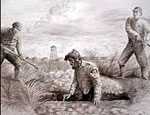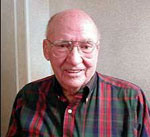By Bob Reha, Minnesota Public Radio
October 1, 2001
In April 1942, Japanese troops force-marched 10,000 Americans and 65,000 Filipinos 65 miles in blazing heat, with little food and water to a prisoner-of-war camp. Thousands died. The event became known as the Bataan Death March. One of the survivors, Ben Steele, documented the experience with a series of drawings, currently on exhibit at Minnesota State University-Moorhead. The exhibit is not just a reminder of the past, but contains clues about what may be ahead as the world battles terrorism.
| ||
Ben Steele sits at a reception and listens as a high school choir sings. Steele, 84, is recovering well from a stroke. He credits his longevity to growing up as a cowboy in the Bull Mountains of Montana.
Charcoal drawings, pen-and-ink sketches , and three oil paintings dot the gallery walls. Thousands of books have been written about the Bataan Death March. Television programs and movies have tried to capture the horror of the prisoners experience. But Ben Steele has literally drawn on happened to him.
"I'm the only one, really, that's done anything to any extent. There have been a few cartoonists and stuff, but they really don't tell the story," he says.
The exhibit features two original drawings done while Steele was a prisoner of war, before he had formal art training. He drew some of the pictures during post-war rehabilitation. Others were made in 1952 after Steele graduated from the Cleveland Institute of Art.
The drawings are simple, dark portrayals of the artist's experience - men begging for food, soldiers being beaten or killed for attempting to drink from roadside springs.
"This was a person at O'Donnell. They found Japanese currency on him and that's what the repercussions were. (He) dug his own grave and then they killed him and put him in it," he says. They shot these Filipinos and put them in the grave and they weren't dead yet and they were making guys cover them up; they buried them alive."
| ||
Some of the drawings hold painful memories. Steele says he was beaten regularly. He can joke about the number of black eyes he'd had. However, he says the 70 drawings still don't capture the complete horror of the experience.
"Some of the real atrocities I've never drawn and I probably never will," he says. "I get a little bit emotional about some of those things."
Steele's art work has also been featured in other Death March veteran's memoirs. "One of my buddies and I in prison camp, I think we were two of the biggest thieves in the whole area, because we would steal everything we could steal to eat or drink."
Clarence "Butch" Larson used some of Steele's drawings for his book, A Long March Home. Larson says Steele's work illustrates perfectly a lesson American's should never forget. "What price is paid for freedom? It's a very hard thing to gain and it's a more difficult thing to lose your freedom," Larson says.
Ben Steele says he felt an obligation to document what happened at Bataan. Sometimes he feels guilty he survived and others didn't. Of the 75,000 Americans and Filipinos who were captured on Bataan, only half survived.
For years Steele hated the Japanese, but eventually realized by continuing to hate his captors, he was still a prisoner. It's a lesson, he says, that is even more important following the September 11th terrorist attacks on the East Coast "because hatred is a very destructive thing and this Bin Laden is going to find that out sooner or later," he says.
Steele's work will remain on display at the Minnesota State University Moorhead Center for the Arts gallery through October 5th.


